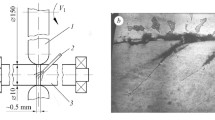Conclusions
-
1.
SN3 steel has a higher corrosion resistance in corrosive media than Kh17N2 steel. Thus, the corrosion resistance of SN3 steel in a 53% sulfuric acid solution (determined by the volume of hydrogen evolved per unit time) is 2.5 times higher than that of Kh17N2 steel.
-
2.
The fatigue limit of SN3 steel in air is 10% higher than that of Kh17N2 steel.
-
3.
The decrease in the fatigue resistance of both steels in 3% NaCl solution with respect to that in air is the same. The corrosion fatigue limit after 2·107 cycles is about one-half that of the fatigue limit in air for both steels.
-
4.
We confirmed the conclusion that there is not direct relationship between the corrosion resistance and corrosion fatigue resistance of metals, since the two steels have very different corrosion resistances, while the decrease of their corrosion fatigue resistance (in aggressive media as compared to air) is the same.
-
5.
SN3 steel is preferable to Kh17N2 steel as a structural material for compressor blades operating under corrosive conditions. However, its corrosion fatigue resistance is too low for use without a protective coating.
-
6.
Coatings of No. 302 insulating lacquer increase the corrosion fatigue resistance of both steels in 3% NaCl solution 1.5 times.
Similar content being viewed by others
Literature Cited
Handbook, Chemical Materials, [in Russian],1, Goskhimizdat (1961).
A. P. Akshentseva, MiTOM, No. 11 (1960).
M. B. Shapiro, A. L. Belinkii, and N. I. Moskvin, Coll: Metals and Alloys in Chemical Machine Construction [in Russian], Trudy NIIKhIMMASh, No. 40, Moscow (1962).
Ya. M. Potak, V. V. Sachkov, and L. S. Popova, MiTOM, No. 5 (1960).
G. V. Akimov, Theory and Methods of Investigation of Corrosion of Metals [in Russian], Moscow-Leningrad, AN SSSR (1945).
N. D. Tomashov, Theory of Corrosion and Protection of Metals [in Russian], Moscow, Izd. AN SSSR (1959).
G. V. Karpenko, Effect of Mechanical Treatment on the Strength and Wear Resistance of Steels [in Russian], Moscow, Mashgiz (1959).
G. V. Karpenko, V. T. Stepurenko, and Yu. I. Babei, Zavodskaya laboratoriya, No. 5, (1963).
L. A. Glikman, Corrosiomechanical Strength of Metals [in Russian], Moscow-Leningrad, Mashgiz (1955).
Author information
Authors and Affiliations
Additional information
Translated from Metallovedenie i Termicheskaya Obrabotka Metallov, No. 10, pp. 28–31, October, 1964
Rights and permissions
About this article
Cite this article
Karpenko, G.V., Meerson, I.L., Babei, Y.I. et al. Resistance of Kh17N2 and SN3 steels to corrosion and corrosion fatigue. Met Sci Heat Treat 6, 609–612 (1964). https://doi.org/10.1007/BF00648700
Issue Date:
DOI: https://doi.org/10.1007/BF00648700




